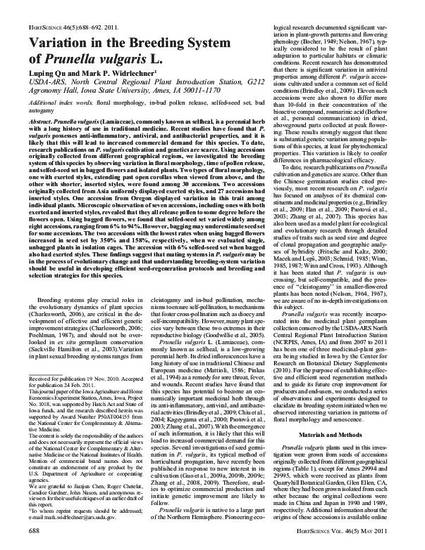
Article
Variation in the Breeding System of Prunella vulgaris L.
HortScience
Document Type
Article
Disciplines
Publication Date
5-1-2011
Abstract
Prunella vulgaris (Lamiaceae), commonly known as selfheal, is a perennial herb with a long history of use in traditional medicine. Recent studies have found that P. vulgaris possesses anti-inflammatory, antiviral, and antibacterial properties, and it is likely that this will lead to increased commercial demand for this species. To date, research publications on P. vulgaris cultivation and genetics are scarce. Using accessions originally collected from different geographical regions, we investigated the breeding system of this species by observing variation in floral morphology, time of pollen release, and selfed-seed set in bagged flowers and isolated plants. Two types of floral morphology, one with exerted styles, extending past open corollas when viewed from above, and the other with shorter, inserted styles, were found among 30 accessions. Two accessions originally collected from Asia uniformly displayed exerted styles, and 27 accessions had inserted styles. One accession from Oregon displayed variation in this trait among individual plants. Microscopic observation of seven accessions, including ones with both exerted and inserted styles, revealed that they all release pollen to some degree before the flowers open. Using bagged flowers, we found that selfed-seed set varied widely among eight accessions, ranging from 6% to 94%. However, bagging may underestimate seed set for some accessions. The two accessions with the lowest rates when using bagged flowers increased in seed set by 350% and 158%, respectively, when we evaluated single, unbagged plants in isolation cages. The accession with 6% selfed-seed set when bagged also had exerted styles. These findings suggest that mating systems in P. vulgaris may be in the process of evolutionary change and that understanding breeding-system variation should be useful in developing efficient seed-regeneration protocols and breeding and selection strategies for this species.
Rights
Works produced by employees of the U.S. Government as part of their official duties are not copyrighted within the U.S. The content of this document is not copyrighted.
Language
en
File Format
application/pdf
Citation Information
Luping Qu and Mark P. Widrlechner. "Variation in the Breeding System of Prunella vulgaris L." HortScience Vol. 46 Iss. 5 (2011) p. 688 - 692 Available at: http://works.bepress.com/mark_widrlechner/9/

This article is from HortScience 46, no. 5 (May 2011): 688–692.